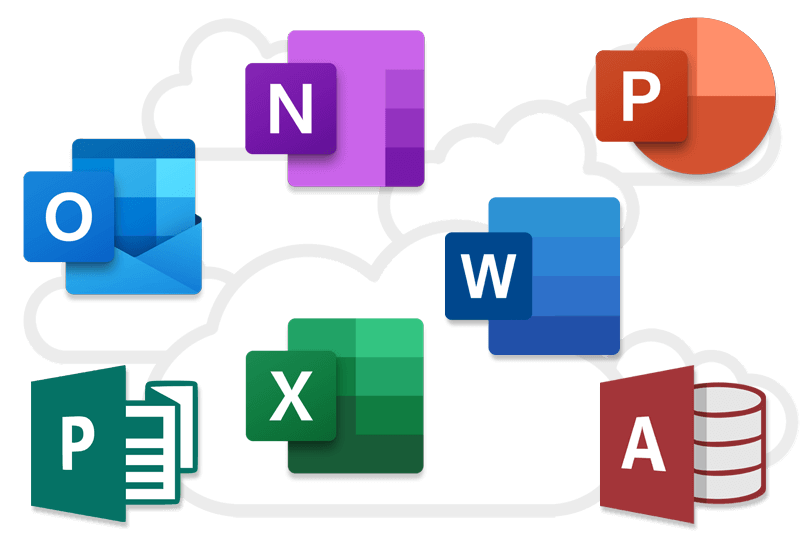Lesser-Known Gems – Microsoft Teams Features
Posted on March 27, 2023 by Fusion Connect
Microsoft Teams boasts numerous features that can significantly improve team collaboration and productivity. While some are well-known, there are several hidden gems that can further elevate your experience. Leveraging Microsoft Teams can help you make the most out of your Microsoft 365 investment.

It is crucial to understand all that Microsoft Teams offers. It is a powerful collaboration tool that can significantly enhance teamwork and productivity. By understanding its full range of features, you can fully leverage the tool’s capabilities to improve workflow and streamline collaboration. Having a thorough understanding of Microsoft Teams enables users to maximize its potential, driving better business outcomes.
Underrated Microsoft Teams Features
Speaker Coach
Speaker Coach in Microsoft Teams is a feature designed to help users improve their public speaking and presentation skills during meetings. It leverages artificial intelligence (AI) to provide real-time feedback and suggestions on your speaking habits, enabling you to be more effective and engaging during virtual meetings.
The key benefits of Speaker Coach include:
- Pace Guidance: Speaker Coach monitors your speaking pace and provides feedback if you are speaking too fast or too slow. Maintaining an optimal pace is crucial for clear communication and ensuring your audience can follow your points.
- Filler Words Detection: The AI identifies filler words (such as "um," "uh," "like," and "you know") and provides feedback on their usage. Reducing filler words makes your speech sound more confident and professional.
- Inclusive Language: Speaker Coach can detect non-inclusive language or phrases, helping you to be more aware of potential biases and helping to promote a more inclusive environment during meetings.
- Monotone Pitch Detection: If you're speaking in a monotone pitch, this tool will provide feedback to help you add more variation to your voice. This can make your presentation more engaging and easier for your audience to listen to.
- Pronunciation Help: Speaker Coach can identify words that are commonly mispronounced and provide guidance on how to pronounce them correctly.
- Recap and Analysis: After your presentation or meeting, Speaker Coach provides a summary of your speaking performance, highlighting areas for improvement and offering personalized tips for becoming an overall better presenter.
To enable Speaker Coach in Microsoft Teams:
- Start a video call with someone.
- Click on the three dots at the top of the screen.
- From the drop-down menu select “Language and Speech”.
- Select the “Speaker Coach” option and turn it on.
By using Speaker Coach in Microsoft Teams, you can refine your communication skills, engage your audience more effectively, and create a more inclusive environment in virtual meetings.
Immersive Reader
Immersive Reader is a handy feature that helps users consume text content more effectively. With functionalities like text-to-speech, adjustable text size and spacing, and focus mode, Immersive Reader makes it easier for users to comprehend and engage with written content in Teams.
To enable Immersive Reader in Microsoft Teams:
- Open a chat.
- Hover your mouse over the message until the three dots appear on the right-hand side of the message.
- Click on the three dots to open the menu.
- From this menu select “More actions” and then “Immersive Reader”.
With Immersive Reader, you can customize the text size, font, and background color to suit your preferences. This feature can also be used to read the text aloud, highlighting parts of speech, and enable translation into other languages. This is a powerful tool that can improve reading comprehension and accessibility.
Message Translation
Message Translation in Microsoft Teams is a valuable feature that allows users to translate chat messages and channel posts into their preferred language in real-time. This helps to break down language barriers, promote inclusivity, and improve communication within globally distributed teams. Some key features and real-life benefits of Message Translation in Microsoft Teams include:
- Real-time Translation: Message Translation uses advanced AI and machine learning algorithms to provide instant translations of chat messages and channel posts, enabling users to understand and participate in conversations that are not in their native language.
- Wide Language Support: Microsoft Teams supports translation for a vast array of languages, allowing team members from diverse linguistic backgrounds to communicate and collaborate effectively.
- Ease of Use: Translating a message is as simple as clicking on the ellipsis (three dots) next to a message and selecting "Translate." The translated message is displayed inline, making it easy for users to follow the conversation without switching between apps or windows.
- Personalized Experience: Users can set their preferred language in their profile settings, ensuring that translated messages are automatically displayed in the language they are most comfortable with.
Real-life Benefits of Message Translation in Microsoft Teams:
- Improved Collaboration: Message Translation enables team members who speak different languages to communicate effectively, leading to better collaboration and a more inclusive work environment.
- Global Team Integration: Organizations with distributed teams across different regions can better integrate their workforce, fostering stronger relationships and promoting knowledge sharing across borders.
- Inclusivity and Diversity: By breaking down language barriers, Message Translation helps create a more inclusive and diverse workplace where everyone can participate and contribute, regardless of their linguistic background.
- Faster Decision-Making: Real-time translation can speed up all knowledge capture and cross-region decisions.
Keyboard Shortcuts
Teams offers numerous keyboard shortcuts that can save time and streamline tasks. From navigating the interface to starting a new chat or managing calls, learning and using these shortcuts can significantly enhance your overall Teams experience.
Shortcuts include:
- Ctrl + E: This shortcut allows you to search within Microsoft Teams. When you press Ctrl + E, the cursor will move to the search bar at the top of the Teams window, allowing you to quickly search for a conversation, file, or person.
- Ctrl + Shift + M: This shortcut is used to mute or unmute your microphone during a call or meeting. When you press Ctrl + Shift + M, your microphone will be muted if it was previously unmuted, or unmuted if it was previously muted.
- Ctrl + Shift + A: This shortcut is used to toggle your camera on or off during a call or meeting. When you press Ctrl + Shift + A, your camera will be turned on if it was previously off, or turned off if it was previously on.
Bookmarking Messages
Microsoft Teams allows users to bookmark important messages, making it easy to find and reference them later. By clicking the "Save this message" option in the chat menu, users can save crucial information and access it quickly when needed.
Follow Channels
In large organizations with numerous channels, it can be challenging to keep track of essential updates. The "Follow Channel" feature in Microsoft Teams enables users to receive notifications for all channel activity, ensuring they stay informed about relevant discussions and updates.
Maximizing Your Microsoft 365 Investment with Microsoft Teams
Microsoft Teams is deeply integrated with Microsoft 365, making it a powerful tool for maximizing your investment in the suite. Below are some ways to harness Teams' capabilities to enhance productivity and collaboration.
Seamless Integration with Office applications
Microsoft Teams integrates with Office applications like Word, Excel, PowerPoint, and OneNote, allowing users to create, edit, and collaborate on documents without leaving the platform. This integration streamlines workflows and minimizes the need to switch between apps.

Utilizing Microsoft Planner
Microsoft Planner, a project management tool included in Microsoft 365, can be integrated with Microsoft Teams. By using Planner within Teams, users can create, assign, and manage tasks, track project progress, and collaborate more effectively.
Centralizing Communication with Outlook
Microsoft Teams allows users to send and receive emails directly within the platform by integrating with Outlook. This feature helps centralize communication, reduce inbox clutter, and keep relevant information easily accessible.
Leveraging Power Automate
Power Automate, a workflow automation tool, can be integrated with Microsoft Teams to create automated processes and save time. By building custom workflows within Teams, users can automate repetitive tasks and improve overall efficiency.
Harnessing the Power of SharePoint
Microsoft Teams and SharePoint are both part of the Microsoft 365 ecosystem. They are designed to work together seamlessly to enhance collaboration, communication, and productivity. By harnessing the power of SharePoint within Microsoft Teams, organizations can benefit from the following features and capabilities:
- File Storage and Sharing: Microsoft Teams uses SharePoint to store and manage files for each team. Files shared within a team or channel are automatically saved in the team's SharePoint document library, allowing for centralized storage, version history, and access control.
- Integration of SharePoint Pages: You can integrate SharePoint pages directly into Microsoft Teams, enabling users to access important content, such as news, lists, or custom web parts, without leaving the Teams interface. This improves the user experience and makes it easier to collaborate on shared content.
- Tab Integration: SharePoint lists, libraries, and pages can be added as tabs in Microsoft Teams channels, providing quick access to important information and making it easier for team members to collaborate on documents, tasks, or other relevant content.
- Collaboration on Office Documents: Microsoft Teams and SharePoint enable real-time co-authoring of Office documents, such as Word, Excel, and PowerPoint files. Users can collaborate on documents directly within the Teams interface, while the files are securely stored in SharePoint.
- Workflow Automation with Power Automate: By integrating Microsoft Teams with SharePoint and Power Automate, you can create custom workflows to automate routine tasks, such as approval processes, notifications, or data synchronization between systems.
- Extensibility with Custom Apps and Web Parts: SharePoint Framework (SPFx) allows developers to create custom web parts, apps, and extensions that can be used in both SharePoint and Microsoft Teams. This enables organizations to tailor the platform to their specific needs and enhance collaboration and productivity.
By leveraging the powerful capabilities of SharePoint within Microsoft Teams, organizations can create a unified and integrated workspace that fosters collaboration, streamlines communication, and boosts productivity.
Fusion Connect is Microsoft Cloud Solution Provider (CSP).




